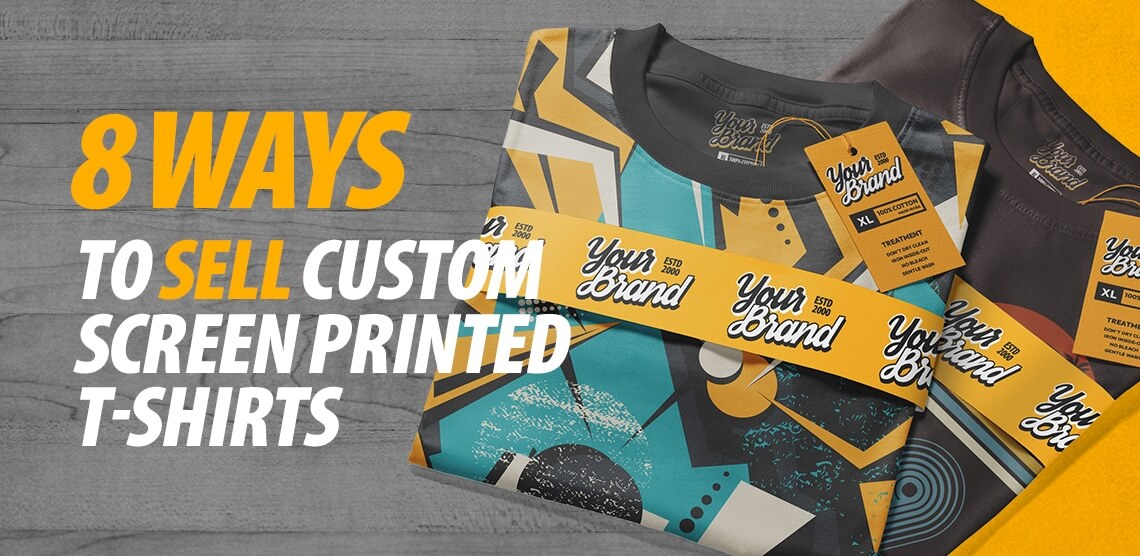Artistic Silk Screen Printing for Limited Edition Prints
Artistic Silk Screen Printing for Limited Edition Prints
Blog Article
Display Printing Uncovered: Whatever You Need to Learn About Tee Shirt and Garment Printing Strategies
If you have actually ever before wondered how those lively layouts end up on your favored t-shirts, you remain in the right area. Display printing is a fascinating technique that combines art with strategy, supplying endless possibilities for creative thinking. Understanding the basics, from tools to ink options, can considerably impact your outcomes. All set to check out the important aspects that make screen publishing an art type? Allow's discover the information that can elevate your jobs.
The Fundamentals of Display Printing: Just How It Works
When you plunge into screen printing, you'll find it's both a science and an art. At its core, display printing entails producing a stencil, or display, that permits ink to go through only in particular areas (screen printing kit). You begin by choosing your style and preparing your display with a light-sensitive emulsion. When you expose this solution to light, it solidifies, leaving your layout as an unfavorable space.
Position the display over the material, after that use a squeegee to press ink via the display onto the garment. Each action is vital, and understanding them will certainly boost your display printing abilities, transforming easy garments into distinct, meaningful pieces.
Kinds Of Display Printing Techniques
As soon as you comprehend the basics of screen printing, it's time to explore the various strategies that can raise your designs. One popular technique is conventional screen printing, where ink is pressed with a stenciled display. This technique is great for vibrant, vivid shades. There's water-based ink printing, which supplies a softer feel and is environmentally friendly, yet it calls for a various strategy to curing.
If you're going for great details, take into consideration discharge printing. This strategy gets rid of color from the textile, leaving a soft, classic look. Another option is plastisol printing, recognized for its sturdiness and vivid shades, making it a favored for numerous brands. Lastly, explore halftone printing to develop slope impacts and complex styles. Each strategy has its unique beauty, so do not wait to try them out to locate what matches your design best!
Vital Tools for Display Printing
To achieve magnificent results in screen printing, having the best devices is fundamental. You'll need a tough display printing frame, which holds the mesh that transfers your layout onto the garment. Next, spend in top quality mops; these are important for using ink equally throughout the screen.
Picking the Right Inks and Materials
When picking inks and products for screen printing, you need to take into consideration the kind of ink that works ideal for your project. Consider material compatibility to ensure your designs look last and excellent long. Also, explore green ink options to make your printing process a lot more lasting.
Sorts Of Display Inks
Picking the right screen ink is necessary for achieving lively, resilient prints that satisfy your project's demands. There are a number of kinds of screen inks to examine. Plastisol ink is preferred for its flexibility and convenience of use, offering exceptional shade opacity on dark textiles. Water-based ink, on the various other hand, uses a softer feeling and is environment-friendly, making it suitable for those wanting to lessen their ecological influence. Discharge inks remove dye from the textile, resulting in a soft, vintage appearance but require particular handling. Finally, specialty inks, such as metal or glow-in-the-dark, can include unique results to your layouts. Examine your job demands and choose the ink that straightens finest with your preferred result.

Textile Compatibility Considerations
Understanding textile compatibility is crucial for achieving high-grade display prints, especially because various products respond distinctively to various inks. When selecting inks, think about the fabric kind-- cotton, polyester, or blends. For cotton, water-based inks work well, using gentleness and breathability. Polyester, on the other hand, typically calls for plastisol inks for far better bond and dynamic colors. You might require to make use of a mix of both types if you're publishing on blends. Always check your inks on sample fabric to ensure they adhere appropriately and keep color stability. Additionally, bear in mind that material weight and appearance can influence the last result, so picking the appropriate ink and material combo is crucial for your job's success.
Eco-Friendly Ink Options
Environment-friendly inks are coming to be a preferred choice for screen printers that desire to reduce their ecological impact while maintaining high quality. When picking inks, consider water-based inks, which are less dangerous and simpler to cleanse up contrasted to typical solvents.
In addition, look for inks made from renewable energies, such as soy or vegetable-based choices. By picking the best inks and products, you'll not just produce sensational layouts however also add to an extra sustainable printing procedure. Make the switch, and your prints will certainly show your commitment to the environment!
Preparing Your Design for Screen Printing

Submit Layout Needs
To ensure your layout looks dynamic and sharp on fabric, you'll require to pay attention to submit style needs for display printing. Beginning with vector data like AI or EPS, as they can be scaled without losing top quality. If you make use of raster pictures, choose high-resolution documents, such as TIFF or PNG, preferably at 300 DPI. Avoid utilizing JPEGs, as they can shed clarity when resized. Additionally, ensure your style has a clear background to avoid undesirable white edges on your prints. Keep color modes in mind; CMYK is basic for display printing, so convert your RGB designs accordingly - screen printing kit. By adhering to these guidelines, you'll establish your artwork up for a successful print.
Shade Separation Methods
Shade separation is a necessary action in preparing your style for display printing, and understanding it can considerably boost your print top quality. You'll need to break your layout right into specific colors, as each color calls for a separate display during printing. Beginning by identifying all the colors in your layout and produce layers for each one. You can website here utilize software like Adobe Photoshop or Illustrator to isolate and different shades effectively. Be particular to conserve each layer as a separate file, generally in a style like TIFF or PSD. This precision not only guarantees accurate color representation yet additionally improves the printing process. By taking notice of color splitting up, you'll attain expert and vibrant outcomes in your screen-printed garments.
Resolution and Size
Accomplishing the most effective cause screen printing begins with guaranteeing your style has the right resolution and dimension. Preferably, your art work needs to be at least 300 DPI (dots per inch) for sharp, clear prints. Your last product might look unprofessional and pixelated. if you use lower resolution.
When it involves dimension, consider the measurements of your print location. Design your art work to match the last print dimension, ideally creating it in the real dimensions you'll be publishing. In this manner, you'll stay clear of any kind of unexpected scaling concerns.
Always inspect your layout in both vector and raster layouts. Vector graphics can be scaled without shedding quality, making them optimal for display printing. Preparing appropriately will guarantee your layout looks remarkable on every garment!
Step-by-Step Screen Printing Refine
Display printing is a dynamic process that enables you to create lively designs on various surfaces. To get begun, you'll require a screen, solution, and your picked ink.
After rinsing the unexposed emulsion, your screen prepares. Establish it up on your printing surface area and straighten your garment beneath it. Put ink onto the display and utilize a squeegee to press the ink with the pattern onto the material. Raise the screen meticulously and allow the print completely dry. Treat the ink utilizing warmth to ensure resilience. That's it! You've efficiently display published your layout.
Tips for Effective Screen Printing Projects
While you're diving into your screen printing tasks, keep in mind that preparation is vital to success. Start by collecting all your materials-- inks, squeegees, screens, and garments. A tidy work area aids avoid undesirable errors, so clean before you begin.
Following, verify your artwork is high-resolution and effectively sized for your garment. Test your screen for appropriate exposure and tidy it completely to avoid smudges. When blending your inks, comply with the supplier's guidelines to attain the best uniformity.
During printing, use also stress with your squeegee for regular outcomes. Don't rush; take your time to validate each print fulfills your requirements. After printing, allow your garments dry completely before taking care of or packaging them.
Finally, always maintain a sample of your benefit future referral. In this manner, you can evaluate your development and enhance your strategies gradually. Delighted printing!

Regularly Asked Concerns
How much time Does It Take to Establish a Display Printing Job?
Establishing up a screen printing task commonly takes about thirty minutes to an hour. You'll prepare the displays, mix inks, and change the press. The moment differs based on intricacy and experience, so remain organized!
Can I Print on Various Material Types Utilizing the Same Strategy?
Yes, you can print on various material kinds making use of the same technique, however you'll require to readjust your inks and settings. Some fabrics soak up ink in different ways, so trying out warranties the ideal outcomes for each and every product.
What Prevail Errors to Stay Clear Of in Screen Printing?
When screen printing, stay clear of typical mistakes like utilizing try this website the incorrect ink, ignoring proper direct exposure times, or avoiding pre-press checks. Constantly evaluate your setup and keep clean displays to ensure high quality outcomes each time.
How Can I Properly Tidy and Keep My Display Printing Equipment?
To appropriately clean and maintain your screen printing tools, you ought to on a regular basis wash screens with suitable solvents, examine mops for wear, and guarantee all devices are stored dry and dust-free. Consistency improves and stops expensive repair work performance.
Is Screen Printing Eco-friendly Contrasted to Other Techniques?
Display printing can be much more eco-friendly than various other approaches, specifically if you make use of eco-conscious materials and water-based inks. By choosing lasting products and techniques, you decrease waste and reduce your impact on the planet.
Display Printing Uncovered: Every Little Thing You Need to Know About Tee and Garment Printing Strategies
At its core, screen printing entails developing a stencil, or display, that permits ink to pass with just in particular areas. Placement the screen over the fabric, then make use of a squeegee to press ink with the display onto the garment. One prominent method is traditional display printing, where ink is pressed through a stenciled display.When selecting inks and materials for display printing, you require to take into account the type of ink that works best for your job.
Report this page